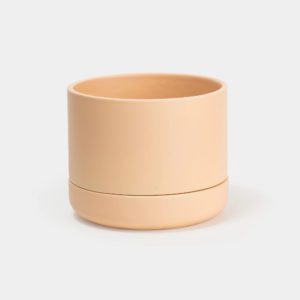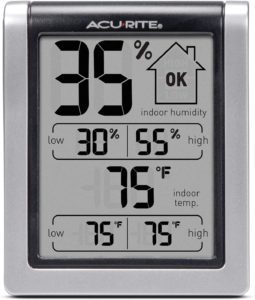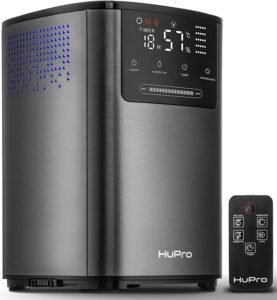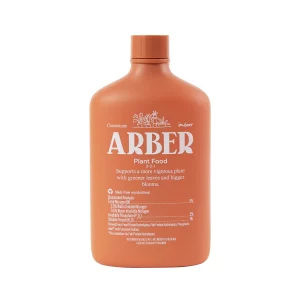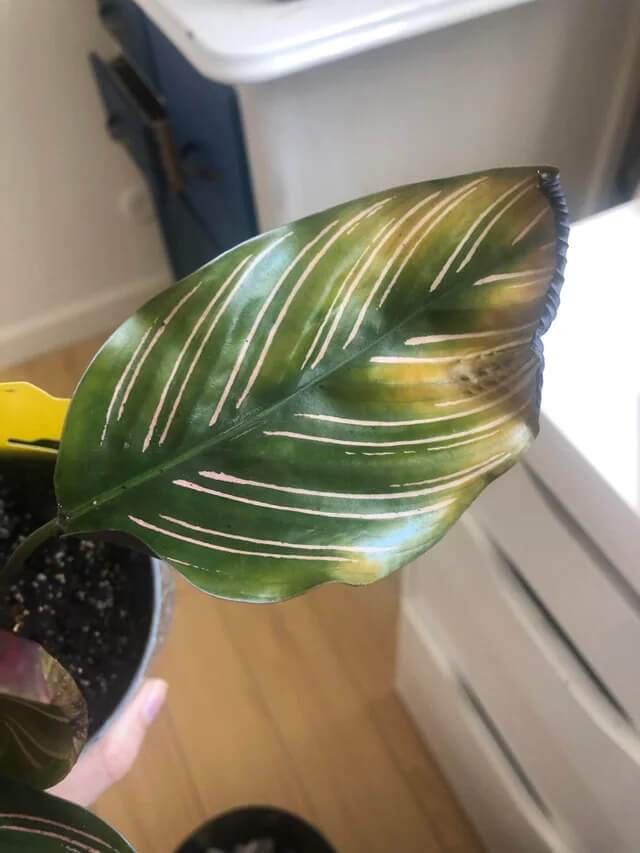Calatheas, or prayer plants, are lovely plants with a range of species, each with strokes of pink, white, or dark green in various patterns on their leaves. Their unique colors and bushiness make calatheas a very popular houseplant, but they are among the more difficult indoor plants to care for.
Calathea plants have delicate roots and higher than average moisture needs, so a particular balance has to be struck for them to be comfortable.
These are known as prayer plants since they fold their leaves up at night, but if you notice your calathea’s leaves are curled or wilting, you should inspect the growing conditions to see what might be stressing them.
I recently visited my Aunt and she had a few calathea plants, so I set out to remedy them. Here’s how to get your calathea plant healthy again!
Causes of calathea leaf curling
Calathea plants are tropical plants from the floors of Central and South American rainforests, where they receive lots of humidity and indirect light in moist, nutrient-dense soil. If their growing conditions aren’t suited to their needs, calatheas will show it on their leaves, particularly by curling.
If you notice a single leaf curling, it’s probably normal from age, but if you notice all of the leaves are curling up, it may be from too much or too little water, too little humidity, or too much light.
Too little light can also cause a calathea’s leaves to curl, as well as too cold of temperatures. Heat, pests, or a nutrient imbalance may also be the causes of curled leaves, so a close look at the growing environment from many angles will help you find the source of the problem.
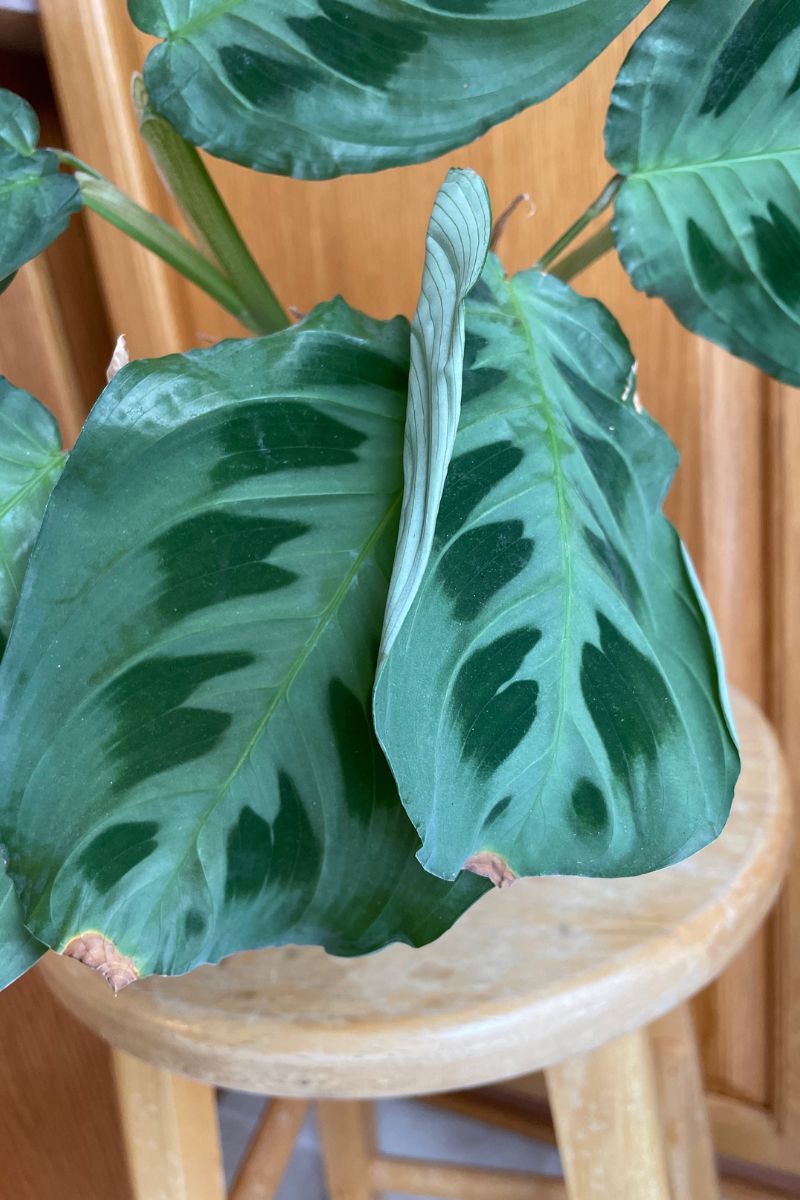
Underwatering – the most common cause
Since Calatheas get so much moisture from the air, they have small roots that don’t store much water. This means they need a regular supply of moisture to keep their leaves firm and smooth, and if they don’t get enough, they can easily dry out. Some Calatheas, like the pinstripe (Calathea Ornata), have thin leaves that dry out more quickly than other types with thicker leaves, like the Calathea Roseopicta.
Younger and smaller plants are at more risk for dehydration than bigger plants because of the size of their pots: small pots lose moisture and dry out more quickly than larger ones, which have more space to hold more moisture, for longer.
A Calathes’s roots shouldn’t totally dry out, so, depending on its size and type, the plant may prefer small amounts of water every few days, rather than one big watering once a week. A self-watering pot is great for moisture-loving calatheas.
Although they like to be kept in moist soil, be sure to not overwater a calathea plant: their delicate roots may dry out easily, but they also can be damaged by too much moisture and develop root rot or be damaged by fungal growth.
A moisture meter can help you keep on top of your plant’s soil and prevent it from drying out.
Low humidity
The small root system of a calathea is owed to the high humidity levels in the tropical rainforests where it originally developed. These plants get much of their moisture needs met by water vapor in the air, and without it, their leaves may lose moisture and curl up from dehydration.
PRO TIP: The average home is kept between 30% to 50% humidity, while calatheas like a bit more moisture in the air at 50% to 60%.
Using a humidifier or placing your calatheas in a steamy spot, like near a shower or kitchen sink, will help keep the air moisture level high enough to keep your calathea happy and free from thirst.
Check the relative humidity of your space with a hygrometer. Most calathea plants prefer a 50 percent or higher humidity level. Some prefer even more humidity.
If your humidity is below 50 percent, then a small plant humidifier tucked behind your Calathea could help the plant a lot.
Too much humidity, however, can create too much wetness that may lead to mildew or tissue damage from moisture saturation. A digital humidifier or air moisture meter will help you maintain the humidity in the right range for your plant(s).
If you have multiple Calatheas, they like to be close to each other to benefit from their transpiration. Too close, however, may block airflow between the plants and create the dark, moist conditions that mildew grows in. Placing plants close enough to each other that they aren’t touching is the best way to get the benefits of a group without damaging any of the individual specimens.
Direct sunlight & heat stress
Calatheas are understory plants, and even though they get a lot of indirect sunlight in nature, the canopy blocks direct light from their leaves. This means that as houseplants, they should be placed in areas that get lots of bright, indirect light, but no direct sunlight.
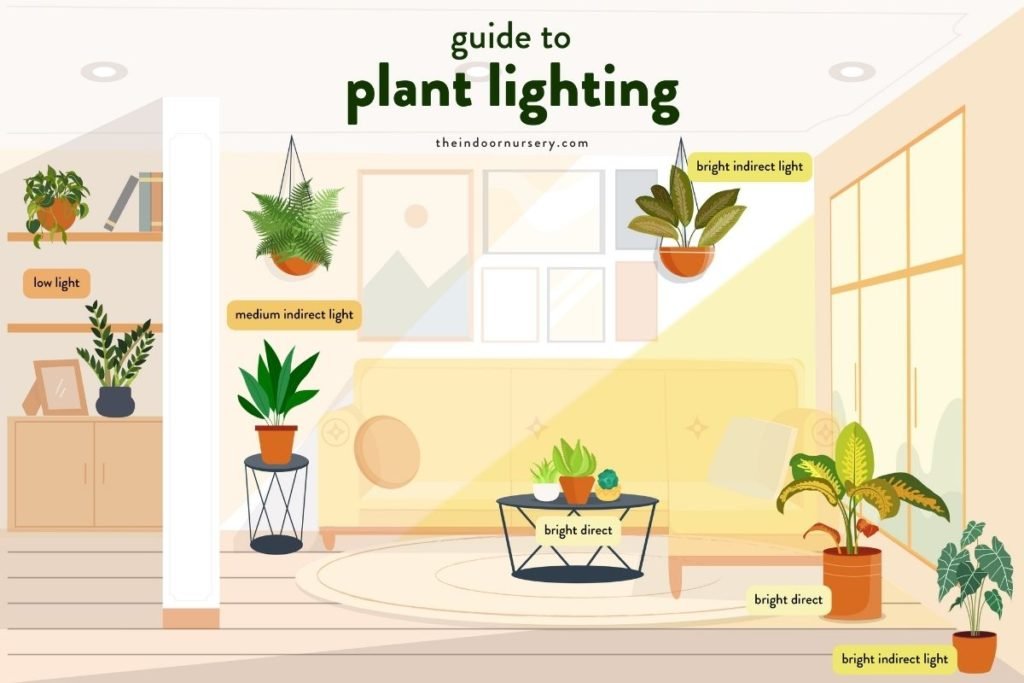
When they get too much direct light, calathea plants curl and fold their leaves if they’re getting too much light in an effort to protect themselves, but this isn’t a long-term solution to the problem, as they’ll eventually dry out or burn.
The sun’s rays can damage a plant by dehydrating or scorching the leaves. The heat from the sunlight will also increase the evaporation rate of the moisture in the soil, which can lead to roots drying out before you water it next. When finding the right spot for your calathea, make sure you put the plant in a medium- to well-lit area that doesn’t get direct sunlight.
This wasn’t the case with my Aunt’s plants. It was snowing outside with grey skies and the plants were in areas with indirect light.
Too little light & cold stress
Even though calatheas are from the forest floor and are shade tolerant, they do need light to survive! Too little light can also lead to curling, wilting leaves as they’re unable to produce enough chlorophyll from a lack of light-driven photosynthesis. Light also provides heat in the form of energy, and too low of temperatures can be just as damaging to plants as too much heat.
Calatheas, as a tropical plant, aren’t cold hearty plants. They shouldn’t be kept by drafty windows or doors, especially during the fall and winter. The leaves of a calathea plant will curl when temperatures get too low in an effort to maintain their temperature, which they prefer to be above 65 degrees.
How to save it:
- Keep your calatheas in a relatively humid room (50 to 60% humidity) that is above 65 degrees Farenheit.
- A small grow tent can provide the perfect environment for calatheas in colder areas.
Watering with hard water
Some plants are more sensitive than others to minerals found in tap water and groundwater. Chlorine and fluoride are added to municipal water supplies to make it safe for humans to drink. In other cases, groundwater in areas with high levels of sodium in the ground can make some well water sources particularly salty, which no plant likes.
Calatheas prefer soft water, without minerals, and their delicate roots are sensitive to hard water that contains those different types of minerals.
How to save it:
- If you’re noticing your calathea plant’s leaves curling or getting brown edges after giving them tap water over a period of time, it may help to switch to filtered or distilled water (they’d also love rain water, if you capture it!)
Pest infestation
Different types of pests will be attracted to a calathea in different circumstances. Spiders or spider mites may show up if the plant isn’t getting enough water or is in too dry of conditions. You’ll notice webs on the plant when spiders are present, and chewed-on leaves if it’s mites, but a dehydrated calathea won’t last too long before the leaves curl, wilt, and drop off.
On the other hand, a too-wet soil can develop fungus that may attract fungus gnats. An overwatered plant, however, will also show signs of damage, and curled calathea leaves with fungus gnats may point to root damage from fungal growth. Inspecting the plant’s condition is a main part of plant care, and if you notice pests showing up, consider the condition or the plant and the soil to figure out the best way to keep pests of your calathea going forward.
How to save it:
- If you notice spiders or spider mites on your calathea, clear the webs, rinse the plant to get the bugs off, and remove any damaged leaves. Keeping the plant in humid conditions with plenty of light and regular watering should keep your plant too moist for those dry pests.
- For a fungus gnat infection, the plant will need to be removed from the pot and put in fresh soil, after washing off its roots with a gentle soap and water to remove any fungus or spores from the plant.
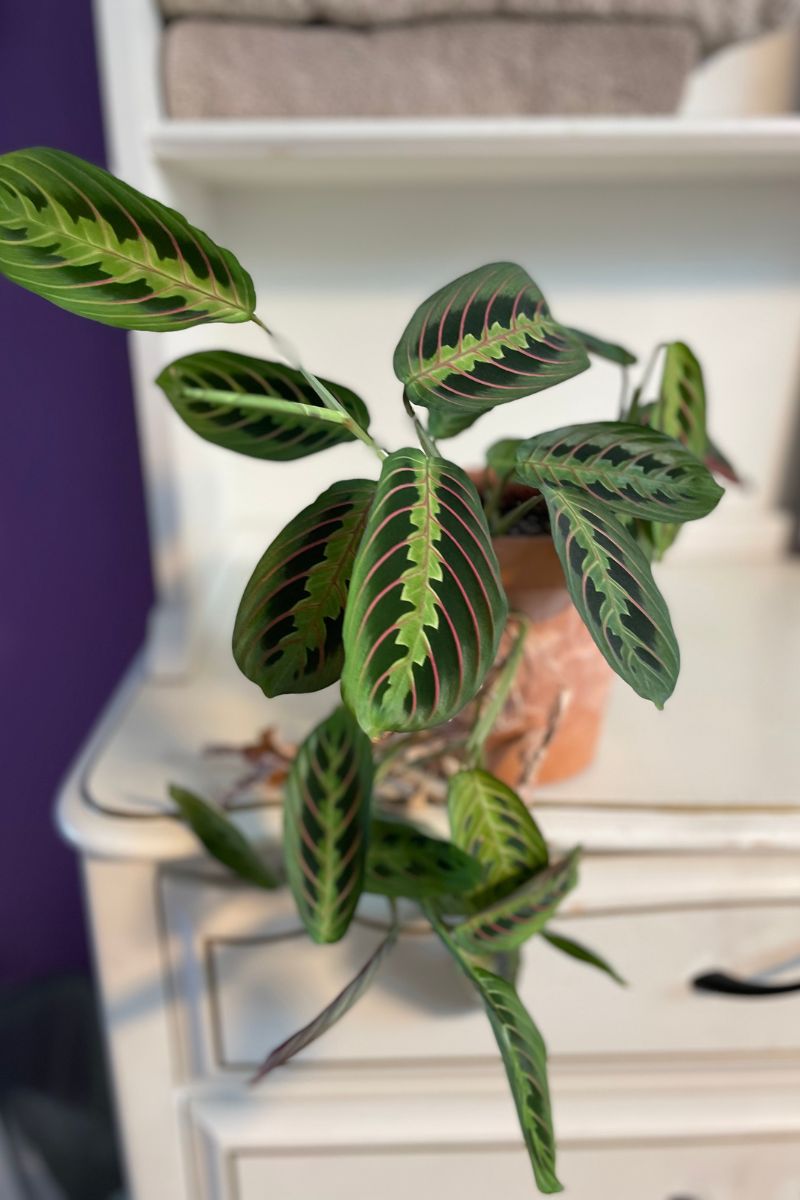
Overfeeding with fertilizer
Although calathea plants are from the rainforest floor, which is rich in nutrients, their small roots can be overwhelmed with a too much fertilizer, and curling leaves may be a sign they’re being overfed. Synthetic fertilizers can be particularly overwhelming for a calathea because they are often salt-based, the method that NPK nutrients, among others, are synthesized for a nutrient-dense product. Over time, those salts can build up in the soil and create a challenging growing environment for your plants.
Using organic fertilizers on sensitive plants like calatheas can help avoid overwhelming the plant with nutrients, especially when using a solid fertilizer like worm castings or compost. Organic materials break down and release their nutrients slowly over time, and will only overwhelm the plant if the additive alters the pH too much, or if it smothers the plant from compaction.
For liquid organic fertilizers, calatheas may like a low dose (one half to one quarter strength) once or twice a month for a regular supply that doesn’t overwhelm the plant. In nature, the topsoil provides a constantly replenishing supply of nutrients to calatheas, so they do appreciate a little more fertilizer than average when compared to other indoor plants.
I really like this organic plant food. It’s made from food waste and comes in sustainable packaging, making it my favorite plant company to feature! But I also find the NPK ratio to be gentle enough for all of my plants:
Overwatering
While calathea plants LOVE humidity, that doesn’t mean that they love sitting in water. Overwatering is a common issue because many plant parents try to compensate for low humidity.
Curling or wilting calathea leaves may be a sign that your plant is getting too much water, something you can notice with a quick inspection of the soil and reflection on how often you water your plant. The small roots can succumb to root rot in wet soil more quickly than plants with heartier roots, and if you notice the roots are soggy, breaking, and black, it may be too late to save it. If the soil is wet but the roots are intact, you may need to simply let it dry out for several days and stop watering so frequently.
Drainage holes in pots are important for calatheas because standing water will lead to the wet soil that can quickly damage their roots. Using a potting soil that drains well is another important aspect of keeping the soil at the good balance of moisture your calathea prefers.
How to prevent Calathea leaves from curling up
As high maintenance plants, some people find Calatheas challenging to keep, but if you get the environmental conditions right, they’ll be happy and able to do their thing!
When caring for your Calathea, avoid curling leaves by keeping these tips in mind:
- Don’t water too little, or too much. A dehydrated plant will show its thirst in curling or drooping leaves, while root damage from wet soil will also reduce leaf firmness as nutrients and moisture can’t be absorbed.
- Keep humidity between 50-60%. Use a humidifier to keep enough water vapor available in the air, and put multiple plants in well-spaced groups so they can benefit from each other’s transpiration.
- Use filtered water. Hard water or water that has been treated with chemicals can stress or damage sensitive Calatheas. Use distilled water or rainwater to keep them happiest.
- Use organic fertilizers. Salt-based synthetic fertilizers can overwhelm sensitive calatheas, so be sure to use low doses of synthetic fertilizers, or slow-release organic matter.
- Place in a spot with bright, indirect sunlight. Too much light can curl leaves by dehydrating or burning them, while too little light can result in damp conditions or low photosynthesis, which will result in curling or wilting.
- Prune dead leaves as necessary. The odd curled leaf is normal as a leaf ages and dies, and it can be snipped off. If a plant is damaged from stress, dead leaves can be clipped and healthy leaves will pick up the slack.
I soaked my aunt’s plants in filtered water and misted with water everyday while I was there and they noticeably perked up! Let me know what you try and how your plants respond in the comments 🙂
more about common questions
- How To Get Rid Of Scale On Plants
- How To Treat A Magnesium Deficiency In Cannabis
- It’s Not O-K: Potassium Deficiency in Cannabis
- How To Make Pothos Fuller (In 5 Minutes)
- Save Your Overwatered Monstera In 4 Steps (And How Not To Do It Again)
- Scale On Monstera: What To Do And How To Save It
- Common Calathea Problems and How to Fix Them

![[SOLVED] Why are my calathea leaves curling?](https://theindoornursery.com/wp-content/uploads/2022/12/why-are-my-calathea-leaves-curling.jpg)
